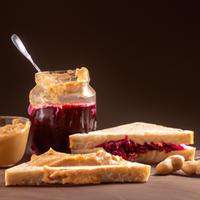
1 serving (100 grams) contains 350 calories, 10.0 grams of protein, 16.0 grams of fat, and 40.0 grams of carbohydrates.

Log this food in SnapCalorie

Nutrition Information
Calories |
833.3 | ||
|---|---|---|---|
% Daily Value* |
|||
| Total Fat | 38.1 g | 48% | |
| Saturated Fat | 7.1 g | 35% | |
| Polyunsaturated Fat | 0 g | ||
| Cholesterol | 0 mg | 0% | |
| Sodium | 714.3 mg | 31% | |
| Total Carbohydrates | 95.2 g | 34% | |
| Dietary Fiber | 7.1 g | 25% | |
| Sugars | 35.7 g | ||
| protein | 23.8 g | 47% | |
| Vitamin D | 0 mcg | 0% | |
| Calcium | 95.2 mg | 7% | |
| Iron | 4.8 mg | 26% | |
| Potassium | 476.2 mg | 10% | |
* Percent Daily Values are based on a 2,000 calorie diet. Your daily values may be higher or lower depending on your calorie needs.
Food Attributes
Source of Calories
About Pb and j sandwich
A PB&J sandwich, short for peanut butter and jelly sandwich, is a classic American staple known for its simplicity and versatility. Made with two slices of bread, a layer of creamy or crunchy peanut butter, and a spread of fruit jelly or jam, this tasty combination strikes a balance of sweet and savory flavors. Its origin dates back to the early 20th century, gaining popularity for its convenience and affordability. From a nutritional perspective, peanut butter provides protein, healthy fats, and essential nutrients like vitamin E and magnesium. The fruit jelly contributes a touch of sweetness, sometimes offering small amounts of vitamin C depending on the variety. Whole-grain bread adds fiber and complex carbohydrates for sustained energy. However, it’s worth noting that many commercial peanut butters and jellies contain added sugars and fats, so opting for natural, low-sugar versions can make this sandwich a healthier choice.



